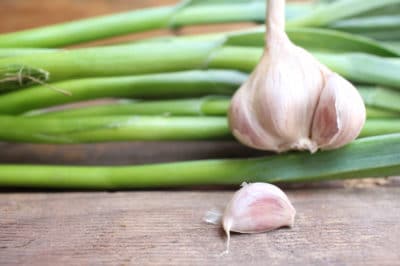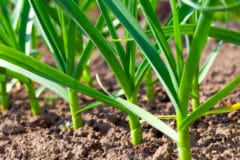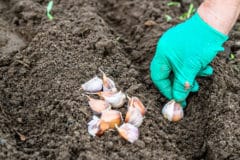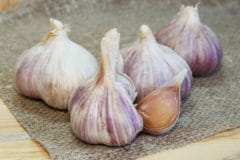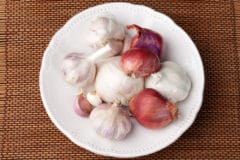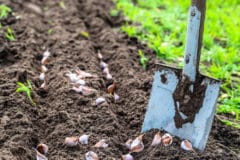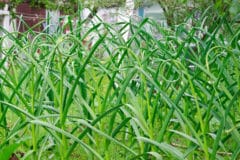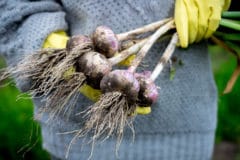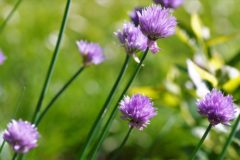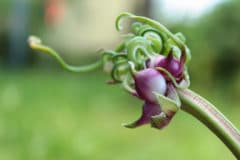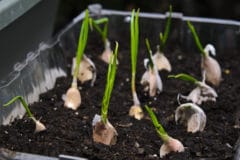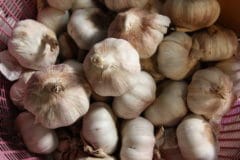What is Garlic?
Garlic isn’t really a vegetable, nor is it an herb – technically, it’s a flowering bulb. Although sometimes called “the stinking rose,” garlic is actually a member of the lily family. The bulb is composed of multiple sections called cloves. The cloves are covered with inedible papery husks, and chopped or crushed garlic has a pungent to spicy flavor and aroma. There are hundreds of varieties.
A number of other garden plants are related to garlic – all are known as alliums. They include onions, in which the individual cloves have been transformed into layers. Shallots are another relative, as are scallions, which may be immature onions or a variety of perennial onion. Leeks are another allium – like scallions, it’s the stalks and lower leaves that are most commonly eaten.
What is Elephant Garlic?
Elephant garlic is technically part of the leek group, although it has a few large cloves that resemble garlic cloves. While regular garlic may have up to 20 cloves, elephant garlic rarely has more than six. In other respects, it does look like a very large garlic clove, which may be how it got its name. In taste, however, it more closely resembles scallions.
Softneck or Hardneck?
Garlic is available in two forms– hardneck and softneck. As the names imply, the first has a hard center stalk, while the other has multiple soft leaves instead. The hardneck garlic produces a flower stalk from which bulbils grow; the bulbils can be planted. Hardneck garlic usually has better storage qualities, but softneck garlic typically has more cloves. Softnecks rarely produce a flower stalk.
What Softneck Garlic Varieties are Available?
Within each major softneck category, you may find dozens of different garlics. Here are a few:
- Artichoke – this is the common supermarket garlic. Within the group flavors vary from the mild Simoneit and Red Toch, through Inchelium Red and Susanville, to the notably more pungent California Later and Lorz Italian.
- Silverskin – the longest storing type and best for braiding. Good varieties include Nootka rose, Silver Rose and Silver White.
What Hardneck Garlic Varieties are Available?
Hardneck garlics are grouped into porcelain, rocambole, Asiatic and purple stripe garlic. Varieties include:
- Carpathian – spicy Polish heirloom.
- Spanish Roja – red tinged, large bulbs and full flavor.
- German Extra-Hardy – milder flavor, excellent storage qualities.
- Georgian Crystal – mild enough to eat raw.
- Chesnok Red – considered a gourmet garlic; has won multiple taste tests.
- Gregory’s China Rose – good for warm winter areas.
Where Can Garlic be Grown?
Garlic is grown literally all over the world. However, it is a temperate climate plant. In very warm climates, garlic is best grown as a late fall crop and harvested before the weather gets hot. If you live in a very cold area, you can plant garlic in fall but must mulch it heavily. Cold climate gardeners can also plant garlic in spring for summer harvest.
Does Garlic Have Pests and Diseases?
Like any plant, garlic is subject to some diseases. Fungal diseases and mildews are most common, and most garlic diseases are soil-borne, so regular rotation of your garlic crop is essential. Nematodes also attack garlic. Bulb mites may attack stalks and leaves. Leaf miners are another insect that likes to feed on garlic leaves. However, the common thrip is the most likely garlic insect pest.
What are Garlic Scapes?
Scapes are the immature flower bud of the garlic plant. They usually grow only on hardneck garlic plants. They are edible and can be used just as you would garlic cloves. Even if you don’t want to eat them, they should be cut off so the plant concentrates on forming cloves instead. Harvest over several weeks as the scapes appear.
How do I Grow Garlic From Seed?
Farming garlic takes lots of hand labor. Softneck garlic cannot be grown from seed, as it rarely produces a seed stalk or flowers. Rocambole garlics produce bulbils, which are planted by hand. Rocambole may also produce seeds, although seeds typically don’t grow well or are sterile. If you do get some seeds from a rocambole, treat them as you would other allium seeds.
How Do I Grow Garlic From Cloves?
Like many bulbous plants, garlic prefers to spread by growing new plants from the cloves. Separate the individual cloves from the clump; make sure they are plump and in good condition. The pointed end must face upward. Plant about three inches deep in furrows six inches apart. Mulch helps protect the cloves, especially in cold winter climates when garlic is planted in the fall.
Can I Grow Garlic in Containers?
Garlic is very adaptable. If you give it the soil, sun and water it needs, it will adapt to container growing. Make sure the soil is at least 12 inches deep. Your containers should have adequate drainage to prevent mildew and molds. Check soil frequently and water as necessary; use fish emulsion to water and fertilize in one go. Be careful not to crowd the plants.
What’s the Best Time to Plant Garlic?
Actually, there are two best times to plant garlic – early spring and late fall. Many gardeners plant some garlic at both of these times so they can be assured of fresh garlic year round. In warm winter climates, fall planting is definitely best. Garlic that is fall-planted in cold winter climates should also be mulched to protect the early sprouts from severe weather.
What’s the Best Soil for Garlic?
Sandy loam is the ideal soil for garlic. This plant likes well-drained soil but not wet feet, so good drainage is important. Well-rotted leaf mold, aged manure, organic compost or a balanced organic fertilizer with nitrogen, phosphorus, potassium and sulfur provide important minerals. Heavy clay soils will grow garlic, but the clay tends to stick to cloves and is hard to clean off.
How do I Water Garlic?
Garlic needs more water in the early growing period. Don’t let garlic dry out; water any time the top inch of soil is dry. However, too much water can encourage mildew and fungal diseases. Planting in raised beds helps ensure the soil will drain well. You should also drain off any puddles. Stop watering once the garlic begins to form heads.
How do I Fertilize Garlic?
Garlic is a heavy feeder and likes more nitrogen than you might think. Prepare the soil well prior to planting, using organic material to add humus that will add nutrients and aid water retention. Work in one to two pounds of a balanced all-purpose 10-10-10 organic fertilizer or two pounds of blood meal per 100 square feet. Fertilize growing garlic with liquid fish emulsion. Hold nitrogen once cloves form.
What are Garlic’s Companion Plants?
Companion planting is based on the theory that certain plants can enhance the growth of other plants, protect them from insects and disease or attract beneficial insects. Garlic is a great companion for fruit trees, as it repels some insects that would damage the fruit. Garlic also mixes well with solanums such as tomatoes, cole crops such as cabbage, and carrots. However, it dislikes beans and peas.
How Do I Store Garlic?
Garlic is best stored in a cool and dry environment, with good air circulation. Garlic should also be kept in the dark to prevent sprouting. The heads should be kept whole and the garlic should not be peeled until just before you cook or eat it. As soon as you break the head, the garlic will begin to deteriorate. It can also be chopped or pureed in oil and frozen.
Can Garlic Protect Other Plants?
Garlic is useful for interplanting with brambles such as roses and raspberries, because it deters rose chafers and the Japanese beetle. Garlic planted among carrots may help ward off carrot flies. Mixing garlic among lettuce and celery can help deter aphids. When planted with cabbage, garlic can decease cabbage worms. Garlic may also help keep rabbits, slugs and snails out of your vegetables.
Can I use Garlic as an Insect Spray?
While garlic spray is not effective against all insects, it does seem to work well on aphids and similar soft-bodied insects. Mince four cloves of garlic, place in a tablespoon of mineral oil and let sit for one day. Strain out the garlic, add oil and one teaspoon of dish soap to a pint of water. Shake well, then mix two tablespoons in another pint of water to spray on plants.
